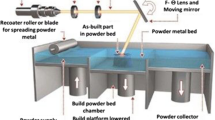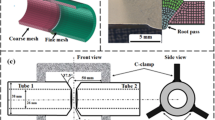Abstract
In this paper, three methods of adding and activating weld bead elements, i.e., adding and activating the weld bead segment by segment (case A), adding and activating one weld pass after another (case B), and modified adding and activating one weld pass after another (case C), were employed to establish the corresponding simulation model of a butt joint of AA6061-T6 mid-thick plate with a double-pass weld by ABAQUS. The welding temperature field, residual stress field, and welding deformation were simulated. The heat loss of three methods in the welding simulation was tested by theoretical calculation. To verify the simulation results, the metal-inert gas (MIG) welding experiment was also performed, and the molten pool dimensions, residual stress, and welding deformation were measured. The results show both cases A and C can be effectively employed to predict residual stress, and case C can also save computing time. Case A can more accurately predict the welding deformation.
Similar content being viewed by others
References
J. Yi, J. M. Zhang, S. F. Cao and P. C. Guo, Effect of welding sequence on residual stress and deformation of 6061-T6 aluminium alloy automobile component, Transactions of Nonferrous Metals Society of China, 29(2) (2019) 287–295.
E. Bonazzi, E. Colombini, D. Panari, A. Vergnano, F. Leali and P. Veronesi, Numerical simulation and experimental validation of MIG welding of t-joints of thin aluminum plates for top class vehicles, Metallurgical and Materials Transactions A: Physical Metallurgy and Materials Science, 48(1) (2017) 379–388.
B. Q. Chen and C. Guedes Soares, Numerical investigation on weld-induced imperfections in aluminum ship plates, Journal of Offshore Mechanics and Arctic Engineering, 141(6) (2019) 061605.
Y. Liu, Design and structural analysis of a 70-m metal space-frame radome, The Structural Design of Tall and Special Buildings, 29(17) (2020) 1–24.
W. Zhang, W. Jiang, X. Zhao and S. T. Tu, Fatigue life of a dissimilar welded joint considering the weld residual stress: experimental and finite element simulation, International Journal of Fatigue, 109 (2018) 182–190.
C. Li, Z. Chen, H. Gao, D. Zhang and X. Han, Numerical simulation of the metal inert gas welding process that considers grain heterogeneity, Proceedings of the Institution of Mechanical Engineers Part L Journal of Materials Design and Applications, 235(1) (2021) 42–58.
M. Mohammadi, S. Golabi and B. Amirsalari, Determining optimum butt-welding parameters of 304 stainless-steel plates using finite element, particle swarm and artificial neural network, Iranian Journal of Science and Technology-Transactions of Mechanical Engineering, 45(3) (2021) 787–800.
R. Reda, M. Magdy and M. Rady, Ti-6Al-4V TIG weld analysis using FEM simulation and experimental characterization, Iranian Journal of Science and Technology-Transactions of Mechanical Engineering, 44(3) (2020) 765–782.
Y. Lu, S. Zhu, Z. Zhao, T. Chen and J. Zeng, Numerical simulation of residual stresses in aluminum alloy welded joints, Journal of Manufacturing Processes, 50 (2020) 380–393.
V. Farajkhah, Y. Liu and L. Gannon, Finite element study of 3D simulated welding effect in aluminium plates, Ships and Offshore Structures, 12(1–2) (2016) 1–13.
X. M. Wang and E. F. Guo, Numerical analysis and verification of residual stress in T joint of S355 steel, Frattura ed Integrità Strutturale, 52 (2020) 25–32.
Q. Guo, B. Du, G. Xu, D. Chen, L. Ma, D. Wang and Y. Zhang, Influence of filler metal on residual stress in multi-pass repair welding of thick P91 steel pipe, International Journal of Advanced Manufacturing Technology, 110(11–12) (2020) 2977–2989.
C. Wu, C. Lee and J. W. Kim, Numerical simulation of bending deformation induced by multi-seam welding of a steel pipe structure, Journal of Mechanical Science and Technology, 34(5) (2020) 2121–2131.
X. Zhan, Q. Zhang, Z. Zhu and Y. Wei, Numerical simulation of resistance welding of solar cell using a thermal-electrical-mechanical coupled model, Journal of Mechanical Science and Technology, 32(1) (2018) 269–276.
Y. Ueda and T. Yamakawa, Analysis of thermal elastic-plastic stress and strain during welding by finite element method, Transactions of the Japan Welding Society, 2(2) (1971) 186–196.
M. R. Nezamdost, M. R. N. Esfahani, S. H. Hashemi and S. A. Mirbozorgi, Investigation of temperature and residual stresses field of submerged arc welding by finite element method and experiments, International Journal of Advanced Manufacturing Technology, 87(1–4) (2016) 615–624.
S. Lu, Q. Zheng, C. Zhang, Y. Wang and D. Deng, A comparative study on computational accuracy and efficiency of welding residual stress and deformation in a Q390 steel thick plate T joint among three kinds of different FEM software, Jixie Gongcheng Xuebao/Journal of Mechanical Engineering, 55(6) (2019) 11–22.
W. F. Huang and J. G. Huang, Welding Guide for Aluminum and Aluminum Alloys, 1st Ed., Hunan Science and Technology Press, Changsha, China (2004).
R. Pramod, N. S. Shanmugam and C. K. Krishnadasan, Studies on cold metal transfer welding of aluminium alloy 6061-T6 using ER 4043, Proceedings of the Institution of Mechanical Engineers, Part L: Journal of Materials: Design and Applications, 234(7) (2020) 924–937.
N. P. Kumar, S. Arungalai Vendan and N. Siva Shanmugam, Investigations on the parametric effects of cold metal transfer process on the microstructural aspects in AA6061, Journal of Alloys and Compounds, 658 (2016) 255–264.
ABAQUS, ABAQUS Analysis User’s Guide, Providence, USA (2016).
Z. He, H. Yu, S. Zhao, J. Xing, D. Li, C. Li, L. Chen and S. Wang, An experimental and numerical analysis of water jet peening of Al6061-T6, International Journal of Advanced Manufacturing Technology, 107(9–10) (2020) 3833–3845.
Z. He, S. Zhao, T. Fu, L. Chen, Y. Zhang, M. Zhang and P. Wang, Experimental and numerical analysis of water jet peening on 6061 aluminum alloy, Journal of Pressure Vessel Technology, Transactions of the ASME, 140(2) (2018) 021406.
D. Liu, P. Zheng, M. Cao, H. Yin, Y. Xu and L. Zhang, A new method of roundness error evaluation based on twin support vector machines, Measurement Science and Technology, 32(7) (2021) 075008.
X. K. Zhu and Y. J. Chao, Effects of temperature-dependent material properties on welding simulation, Computers and Structures, 80(11) (2002) 967–976.
N. Zina, S. Zahaf, S. A. Bouaziz, A. Brahami, M. Kaid, B. Chetti and Z. Najafi Vafa, Numerical simulation on the effect of friction stir welding parameters on the peak temperature, von mises stress, and residual stresses of 6061-T6 aluminum alloy, Journal of Failure Analysis and Prevention, 19(6) (2019) 1698–1719.
J. Goldak, A. Chakravarti and M. Bibby, A new finite element model for welding heat sources, Metallurgical Transactions B, 15(2) (1984) 299–305.
J. Wang, X. Yin and H. Murakawa, Experimental and computational analysis of residual buckling deformation of bead-on-plate welded joint, Journal of Materials Processing Technology, 213(8) (2013) 1447–1458.
D. Deng, FEM prediction of welding residual stress and distortion in carbon steel considering phase transformation effects, Materials and Design, 30(2) (2009) 359–366.
Acknowledgments
The authors thank Chenlong Group Co., Ltd. for the use of welding equipment and material. The authors also thank Dongliang Liu and Zhenhui Sun for their help in revising this paper. This work was supported by the National Natural Science Foundation of China (No. 51305408) and the Science and Technology Planning Project of Zhejiang Province (No. 2019C05008).
Author information
Authors and Affiliations
Corresponding author
Additional information
Yanmin Li is an Associate Professor of the School of Mechanical and Power Engineering, Zhengzhou University, Zhengzhou, China. He received his Ph.D. in Mechanical Engineering from Zhejiang University, Hangzhou, China. His research interests include welded space structure of aluminum alloy, aluminum alloy welding, and welding joint strengthening.
Rights and permissions
About this article
Cite this article
Zhao, S., Li, Y., Huang, R. et al. Numerical study of the residual stress and welding deformation of mid-thick plate of AA6061-T6 in the multi-pass MIG welding process. J Mech Sci Technol 35, 4931–4942 (2021). https://doi.org/10.1007/s12206-021-1012-3
Received:
Revised:
Accepted:
Published:
Issue Date:
DOI: https://doi.org/10.1007/s12206-021-1012-3




